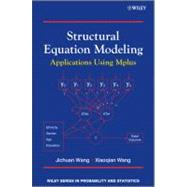
Note: Supplemental materials are not guaranteed with Rental or Used book purchases.
Purchase Benefits
What is included with this book?
Jichuan Wang, Children’s National Medical Center, The George Washington University, USA
Xiaoqian Wang, Mobley Group Pacific Ltd., P.R. China
Preface ix
1 Introduction 1
1.1 Model formulation 2
1.1.1 Measurement model 4
1.1.2 Structural model 6
1.1.3 Model formulation in equations 7
1.2 Model identification 11
1.3 Model estimation 14
1.4 Model evaluation 17
1.5 Model modification 23
1.6 Computer programs for SEM 24
Appendix 1.A Expressing variances and covariances among observed variables as functions of model parameters 25
Appendix 1.B Maximum likelihood function for SEM 27
2 Confirmatory factor analysis 29
2.1 Basics of CFA model 30
2.2 CFA model with continuous indicators 42
2.3 CFA model with non-normal and censored continuous indicators 58
2.3.1 Testing non-normality 58
2.3.2 CFA model with non-normal indicators 59
2.3.3 CFA model with censored data 65
2.4 CFA model with categorical indicators 68
2.4.1 CFA model with binary indicators 69
2.4.2 CFA model with ordered categorical indicators 77
2.5 Higher order CFA model 78
Appendix 2.A BSI-18 instrument 86
Appendix 2.B Item reliability 86
Appendix 2.C Cronbach’s alpha coefficient 88
Appendix 2.D Calculating probabilities using PROBIT regression coefficients 88
3 Structural equations with latent variables 903.1 MIMIC model 90
3.2 Structural equation model 119
3.3 Correcting for measurement errors in single indicator variables 130
3.4 Testing interactions involving latent variables 134
Appendix 3.A Influence of measurement errors 139
4 Latent growth models for longitudinal data analysis 141
4.1 Linear LGM 142
4.2 Nonlinear LGM 157
4.3 Multi-process LGM 183
4.4 Two-part LGM 188
4.5 LGM with categorical outcomes 196
5.1.1 Multi-group first-order CFA 212
5.1.2 Multi-group second-order CFA 245
5.2 Multi-group SEM model 268
5.3 Multi-group LGM 278
6 Mixture modeling 289
6.1 LCA model 290
6.1.1 Example of LCA 296
6.1.2 Example of LCA model with covariates 309
6.2 LTA model 318
6.2.1 Example of LTA 320
6.3 Growth mixture model 340
6.3.1 Example of GMM 342
6.4 Factor mixture model 365
Appendix 6.A Including covariate in the LTA model 375
7.2 Satorra and Saris’s method for sample size estimation 393
7.2.1 Application of Satorra and Saris’s method to CFA model 394
7.2.2 Application of Satorra and Saris’s method to LGM 401
7.3 Monte Carlo simulation for sample size estimation 405
7.3.1 Application of Monte Carlo simulation to CFA model 406
7.3.2 Application of Monte Carlo simulation to LGM 412
7.3.3 Application of Monte Carlo simulation to LGM with covariate 415
7.3.4 Application of Monte Carlo simulation to LGM with missing values 417
7.4 Estimate sample size for SEM based on model fit indices 422
7.4.1 Application of MacCallum, Browne and Sugawara’s method 423
7.4.2 Application of Kim’s method 424
References 429
Index 447
The New copy of this book will include any supplemental materials advertised. Please check the title of the book to determine if it should include any access cards, study guides, lab manuals, CDs, etc.
The Used, Rental and eBook copies of this book are not guaranteed to include any supplemental materials. Typically, only the book itself is included. This is true even if the title states it includes any access cards, study guides, lab manuals, CDs, etc.